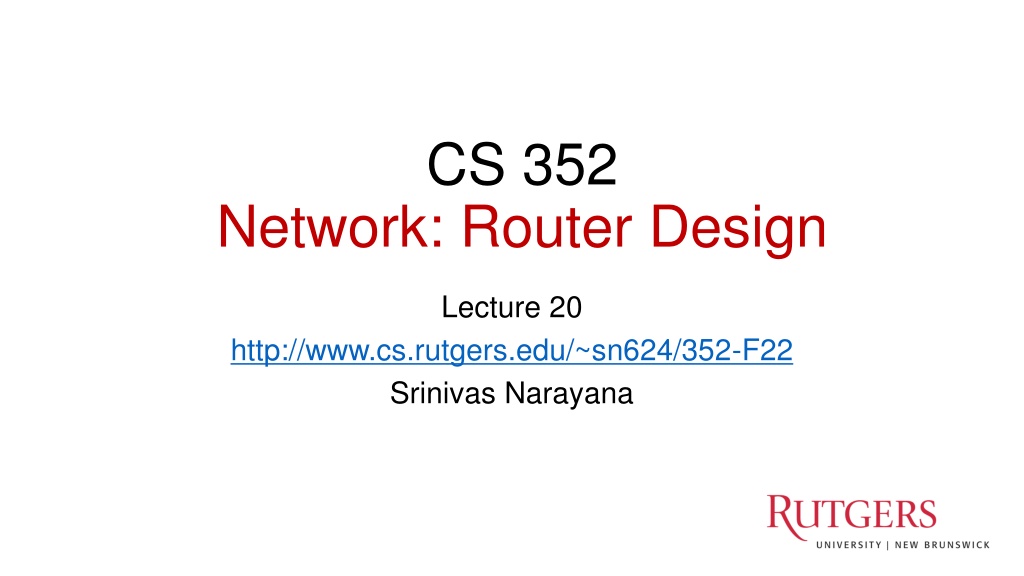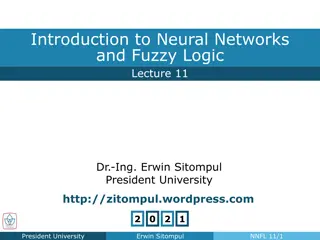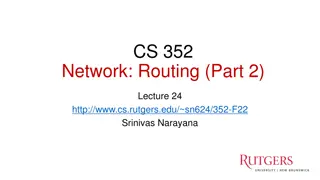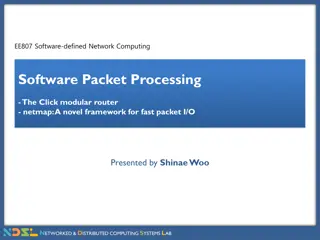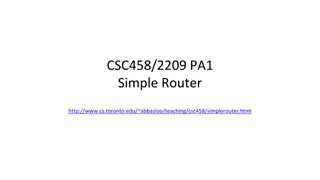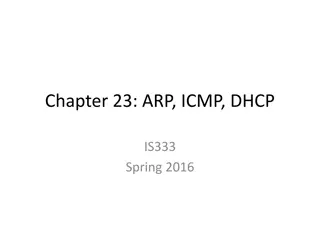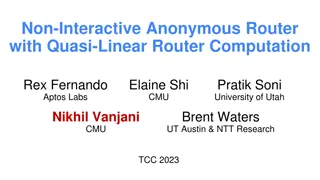Understanding Network Layer Concepts in Router Design Lecture
This content delves into the fundamental concepts of network layer functions in router design, including data forwarding, control plane operations, and route processing. It explains the analogy of the postal system to address and locate network endpoints, and emphasizes the importance of route lookups and packet forwarding based on destination IP addresses. Additionally, it explores input and output port functions, switching fabric operations, and the significance of designing hardware and software for efficient routing table lookups.
Download Presentation

Please find below an Image/Link to download the presentation.
The content on the website is provided AS IS for your information and personal use only. It may not be sold, licensed, or shared on other websites without obtaining consent from the author. Download presentation by click this link. If you encounter any issues during the download, it is possible that the publisher has removed the file from their server.
E N D
Presentation Transcript
CS 352 Network: Router Design Lecture 20 http://www.cs.rutgers.edu/~sn624/352-F22 Srinivas Narayana 1
Review of concepts Network layer s main function: moving data from one endpoint to another Analogy: postal system Addressing (IPv4) Locate, not identify Network layer endpoint endpoint Forwarding Data plane Routing Control plane 10000000 11000011 00000001 01010000 128 195 . . . 1 80 Classless (CIDR) IP prefixes == zip code 128.195.0.0/20
Review of concepts Control plane route processor high-speed switching fabric router input ports router output ports Data plane MGR router
Input port functions Input port Output port Switching fabric Input port Output port Route lookup: high-speed lookup of which output port the packet is destined to Input port Output port Goal: must complete this processing at the line rate Link Layer / MAC (receive) Per-output Queues Route lookup Queueing: packets may wait in per-output-port queues if packets are arriving too fast for the switching fabric to send them to the output port Line Term switching fabric
Route lookups Line Term Route lookup Link Layer Per-output Queues Packet forwarding in the Internet is based on the destination IP address on the packet. Extract destination IP address Transport Parse Network Link layer Route Lookup Data Structure Outgoing Port Example: if dst IP on packet is 65.45.145.34, it matches the forwarding table prefix 65.0.0.0/8. The packet is forwarded out port 3. Example 2: what about dst IP 128.9.5.6? Forwarding Table Dst-network Port 65.0.0.0/8 128.9.0.0/16 3 1 149.12.0.0/19 7
Route lookups Line Term Route lookup Link Layer Per-output Queues Extract destination IP address Transport Parse Number of entries in the forwarding table matters. Fitting into router memory Designing hardware and software for fast lookups Network Link layer Route Lookup Data Structure Outgoing Port Forwarding Table Dst-network Port 65.0.0.0/8 128.9.0.0/16 3 1 149.12.0.0/19 7
Route lookups Line Term Route lookup Link Layer Per-output Queues Extract destination IP address Transport Parse Recall: IP addresses can be aggregated based on shared prefixes. The number of table entries in a router is proportional to the number of prefixes, NOT the number of endpoints. Today: ~ 1 million prefixes. Network Link layer Route Lookup Data Structure Outgoing Port Forwarding Table Dst-network Port 65.0.0.0/8 128.9.0.0/16 3 1 149.12.0.0/19 7
Route lookups Line Term Route lookup Link Layer Per-output Queues Destination-IP-based forwarding has consequences. Forwarding behavior is independent of the source: legitimate source vs. malicious attack traffic Forwarding behavior is independent of the application: web traffic vs. file download vs. video IP-based packet processing is baked into router hardware: evolving the IP protocol faces tall deployment hurdles Extract destination IP address Transport Parse Network Link layer Route Lookup Data Structure Outgoing Port Forwarding Table Dst-network Port 65.0.0.0/8 128.9.0.0/16 3 1 149.12.0.0/19 7
Output port functions Input port Output port Switching fabric Input port Output port Components in reverse order of those in the input port This is where most routers have the bulk of their packet buffers Recall discussions regarding router buffers from transport MGR uses per-port output buffers, but modern routers have shared memory buffers More efficient use of memory under varying demands Input port Output port Link Layer / MAC (transmit) Queues Line Termination Switching fabric To output link
Output port functions Input port Output port Switching fabric Input port Output port Two important policy decisions Scheduling: which among the waiting packets gets to be transmitted out the link? Ex: First-In-First-Out (FIFO) Buffer management: which among the packets arriving from the fabric get space in the packet buffer? Ex: Tail drop: later packets dropped first Input port Output port Link Layer / MAC (transmit) Queues Line Termination Switching fabric To output link
Input port Output port Fabrics: Types Switching fabric Input port Output port Fabric goal: Ferry as many packets as possible from input to output ports as quickly as possible. Input port Output port Input port writes packets into shared memory. Output port reads the packet when output link ready to transmit. Each input port has a physical data path to every output port. Switch at the cross-over points turns on to connect pairs of ports. Single shared channel to move data from input to output port. Easy to build buses; technology is quite mature.
Input port Output port Fabrics: Types Switching fabric Input port Output port Input port Output port Crossbars can get expensive as the number of ports grows (N2 connections for N ports) MGR uses a crossbar and schedules (in,out) port pairs. Modern high-speed routers use highly optimized shared- memory-based interconnects.
Input port Output port Nonblocking fabrics Switching fabric Input port Output port Input port Output port High-speed switching fabrics designed to be nonblocking: If an output port is available , an input port can always transmit to it without being blocked by the switching fabric itself Nontrivial to achieve Crossbars are nonblocking by design Shared memory can be designed to be nonblocking if the memory access is fast enough
Input port Output port Nonblocking fabrics Switching fabric Input port Output port Input port Output port With a nonblocking fabric, queues aren t formed due to the switching fabric. With a nonblocking fabric, there are no queues due to inefficiencies at the input port or the switching fabric Queues only form due to contention for the output port Fundamental, unavoidable, given the route
Input port Output port Nonblocking fabrics Switching fabric Input port Output port Input port Output port With a nonblocking fabric, queues aren t formed due to the switching fabric. With a nonblocking fabric, there are no queues due to inefficiencies at the input port or the switching fabric Queues only form due to contention for the output port Fundamental, unavoidable, given the route Typically, these queues form on the output side But can also backpressure to the input side if there is high contention for the output port i.e.: can t move pkts to output Qs since buffers full, so buffer @ input
Control (plane) processor A general-purpose processor that programs the data plane: Forwarding table Scheduling and buffer management policy Implements the routing algorithm by processing routing protocol messages Mechanism by which routers collectively solve the Internet routing problem More on this soon. Control Processor Input port Output port Switching fabric Input port Output port Input port Output port
Router design: the bigger picture Control plane Traditional distributed routing: per route- change processing (~ a few tens of seconds) Routing Algorithm control plane data plane Data plane per-packet processing (~ tens of nanoseconds) 0111 1 2 3 values in arriving packet header, i.e, destination IP address
Review: Route lookup Table lookup matches a packet against an IP prefix Ex: 65.12.45.2 matches 65.0.0.0/8 Extract destination IP address Transport Parse Network Link layer Prefixes are allocated to organizations by Internet registries Route Lookup Data Structure Outgoing Port Forwarding Table Dst-network Port But organizations can reallocate a subset of their IP address allocation to other orgs 65.0.0.0/8 128.9.0.0/16 3 1 149.12.0.0/19 7
Example of IP block reallocation Dst IP Prefix Output port Suppose ISP A reallocates a part of its IP block to orgs 1 8 65.0.0.0/8 128.9.0.0/16 200.23.16.0/20 3 1 7 (towards A) ISP A owns the IP block 200.23.16.0/20. Organization 1 200.23.16.0/23 200.23.18.0/23 Organization 2 ... ISP A 200.23.20.0/23 Organization 3 ... Internet Organization 8 200.23.30.0/23 There is an announcement mechanism (BGP) by which ISP A can inform the rest of the Internet about the prefixes it owns. It is enough to announce a coarse-grained prefix 200.23.16.0/20 rather than 8 separate sub-prefixes. Route Aggregation Save forwarding table memory Fewer routing protocol msgs
Example of IP block reallocation Dst IP Prefix Output port Suppose ISP A reallocates a part of its IP block to orgs 1 8 65.0.0.0/8 128.9.0.0/16 200.23.16.0/20 3 1 7 (towards A) ISP A owns the IP block 200.23.16.0/20. Organization 1 200.23.16.0/23 200.23.18.0/23 Organization 2 ... ISP A 200.23.20.0/23 Organization 3 ... Internet Organization 8 200.23.30.0/23 Now suppose one of these organizations adds another ISP for its Internet service and prefers using the new ISP. Note: it s possible for the organization to retain its assigned IP block.
Example of IP block reallocation Dst IP Prefix Output port Suppose ISP A reallocates a part of its IP block to orgs 1 8 65.0.0.0/8 128.9.0.0/16 200.23.16.0/20 3 1 7 (towards A) ISP A owns the IP block 200.23.16.0/20. Organization 1 200.23.16.0/23 200.23.18.0/23 Organization 2 ... ISP A 200.23.20.0/23 Organization 3 ... Internet Organization 8 200.23.30.0/23 ISP B Organization 2 200.23.18.0/23
Example of IP block reallocation Dst IP Prefix Output port Suppose ISP A reallocates a part of its IP block to orgs 1 8 65.0.0.0/8 128.9.0.0/16 200.23.18.0/23 200.23.16.0/20 3 1 4 (towards B) 7 (towards A) ISP A owns the IP block 200.23.16.0/20. Organization 1 200.23.16.0/23 200.23.18.0/23 Organization 2 ... ISP A 200.23.20.0/23 Organization 3 ... Internet Organization 8 200.23.30.0/23 ISP B Organization 2 200.23.18.0/23
A closer look at the forwarding table Dst IP Prefix Output port 200.23.18.0/23 is inside 200.23.16.0/20 65.0.0.0/8 128.9.0.0/16 200.23.18.0/23 200.23.16.0/20 3 1 4 (towards B) 7 (towards A) A packet with destination IP address 200.23.18.xx is in both prefixes i.e., both entries match Q: How should the router choose to forward the packet? The org prefers B, so should choose B 200.23.16.0/20 The Internet uses a policy to prioritize: Longest Prefix Matching
Longest Prefix Matching (LPM) Dst IP Prefix Output port Use the longest matching prefix, i.e., the most specific route, among all prefixes that match the packet. 65.0.0.0/8 128.9.0.0/16 200.23.18.0/23 200.23.16.0/20 3 1 4 (towards B) 7 (towards A) Policy borne out of the Internet s IP allocation model: prefixes and sub-prefixes are handed out Internet routers use longest prefix matching. Very interesting algorithmic problems Challenges in designing efficient software and hardware data structures 200.23.16.0/20
Internet routers perform longest- prefix matching on destination IP addresses of packets.
Verizon Rutgers Why is LPM prevalent? AT&T An ISP (e.g., Verizon) has allocated a sub-prefix (or subnet ) of a larger prefix that the ISP owns to an organization (e.g., Rutgers) Further, the ISP announces the aggregated prefix to the Internet to save on number of forwarding table memory and number of announcements The organization (e.g., Rutgers) is reachable over multiple paths (e.g., through another ISP like AT&T) The organization has a preference to use one path over another, and expresses this by announcing the longer (more specific) prefix Routers in the Internet must route based on the longer prefix
